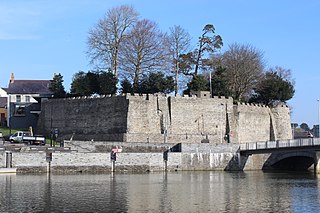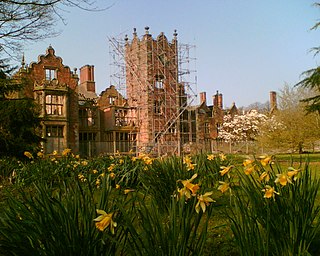
Amlwch is a port town and community in Wales. It is situated on the north coast of the Isle of Anglesey, on the A5025 which connects it to Holyhead and to Menai Bridge. As well as Amlwch town and Amlwch Port, other settlements within the community include Burwen, Porthllechog/Bull Bay and Pentrefelin. The town has a beach in Llaneilian, and it has significant coastal cliffs. Tourism is an important element of the local economy. At one time it was a booming mining town that became the centre of a vast global trade in copper ore. The harbour inlet became a busy port and significant shipbuilding and ship repair centre, as well as an embarkation point with boats sailing to the Isle of Man and to Liverpool. The community covers an area of about 18 square kilometres.

Menai Bridge is a town and community on the Isle of Anglesey in north-west Wales. It overlooks the Menai Strait and lies by the Menai Suspension Bridge, built in 1826 by Thomas Telford, just over the water from Bangor. With a population of 3,376, it is the fifth largest town on the island. The built-up area including Llandegfan had a population of 4,958.
Llandegfan is a village on the east of island of Anglesey in Wales. It is part of the community of Cwm Cadnant. Population is around 1,580.

Cardigan Castle is a castle overlooking the River Teifi in Cardigan, Ceredigion, Wales. It is a Grade I listed building. The castle dates from the late 11th-century, though was rebuilt in 1244. Castle Green House was built inside the castle walls in the early 1800s. After falling into disrepair the castle was restored in the early 2000s and opened to the public in 2015. It is owned by Ceredigion County Council and now includes a heritage centre and open-air concert facilities. The castle's gardens are listed on the Cadw/ICOMOS Register of Parks and Gardens of Special Historic Interest in Wales.

Penmynydd, meaning "top of the mountain" in Welsh, is a village and community on Anglesey, Wales. It is known for being the birthplace of the Tudors of Penmynydd, which became the House of Tudor. The population according to the United Kingdom Census 2011 was 465. The community includes the village of Star.

Plas Newydd is a country house set in gardens, parkland and surrounding woodland on the north bank of the Menai Strait, in Llanddaniel Fab, near Llanfairpwllgwyngyll, Anglesey, Wales. The current building has its origins in 1470, and evolved over the centuries to become one of Anglesey's principal residences. Owned successively by Griffiths, Baylys and Pagets, it became the country seat of the Marquesses of Anglesey, and the core of a large agricultural estate. The house and grounds, with views over the strait and Snowdonia, are open to the public, having been owned by the National Trust since 1976.

Beaudesert was an estate and stately home on the southern edge of Cannock Chase in Staffordshire. It was one of the family seats of the Paget family, the Marquesses of Anglesey. The estate was obtained by William Paget, 1st Baron Paget in 1546; the family's other main seat is at Plas Newydd.

The Afon Cadnant is a small river on Anglesey, North Wales, which drains to the Menai Strait about 1 km north-east of the Menai Suspension Bridge. The river drains a largely agricultural area from Llandegfan to Llansadwrn and beyond, with feeder tributaries extending up towards Pentraeth forest.
Mark Baker is an architectural historian and author of several books on country houses, estates and their families. Baker has contributed to several television series and programmes. He became a Welsh Conservative Party councillor for Gele in May 2017.

Plas Brondanw in Garreg, Llanfrothen, Gwynedd, North Wales, was the family home of Clough Williams-Ellis, creator of the Italianate village Portmeirion, and elements of similar architectural styles can be seen at both locations. It is a grade II* listed building. The gardens, in a series of garden rooms enclosed by yew hedges and open lawns, linked by carefully planned vistas, is one of only three Grade I listed gardens in Gwynedd.

Woodstock House and Estate is a derelict Georgian house and estate located near Inistioge, County Kilkenny, Ireland, on the west bank of the River Nore. The Ladies of Llangollen story began here and Mary Tighe died here. The house was destroyed by presumed arson after it was used a billet by the British army. The house is still a ruin but the gardens are open to the public.

Dumfries House is a Palladian country house located in the town of Cumnock in East Ayrshire, Scotland. It is within a large estate, around two miles (3 km) west of Cumnock. Noted for being one of the few such houses with much of its original 18th-century furniture still present, including specially commissioned Thomas Chippendale pieces, the house and estate is now owned by The Prince's Foundation, a charity which maintains it as a visitor attraction and hospitality and wedding venue. Both the house and the gardens are listed as significant aspects of Scottish heritage.
Pentre Berw is a small village located on the island of Anglesey in north Wales. It lies about 2 miles (3.2 km) south of the county town of Llangefni, and next to Gaerwen.

Newton House is a Grade II* listed country house situated just to the west of the market town of Llandeilo in Carmarthenshire, Wales. It is partially owned and maintained by the National Trust and lies within Dinefwr Park and the grounds of Dinefwr Castle. The park and gardens are listed on the Cadw/ICOMOS Register of Parks and Gardens of Special Historic Interest in Wales. The original house was built during the Medieval period on a site which has been occupied for at least two millennia. The current house was built by Edward Rice in the Jacobean style in 1660, though extensive changes were made in the 1850s in the Venetian Gothic style. The house played a role in the Rebecca Riots of 1843, when the occupant of the house at the time, Colonel George Rice, received a death threat with an empty grave dug in the ground. After 1956 the property fell into turbulent times when two owners died within the space of a few years. It was sold in 1974, and later fell into disrepair; it was occupied by squatters and thieves who removed beams and furniture.

Bodelwyddan Castle, close to the village of Bodelwyddan, near Rhyl, Denbighshire in Wales, was built around 1460 by the Humphreys family of Anglesey as a manor house. It was associated with the Williams-Wynn family for around 200 years from 1690. It has been a Grade II* listed building since 1962 as a "Gothick castellated style in the early C19". Having been opened to the public as a historic house museum, as of mid 2019, it was up for sale and the historic building was closed to the public.

Glynllifon is the name of the old estate which belonged to the Barons Newborough, near the village of Llandwrog on the main A499 road between Pwllheli and Caernarfon in Gwynedd, Wales. The original mansion was until recently a privately owned hotel.

Bedwellty House is a Grade II-listed house and gardens in Tredegar, in the Sirhowy Valley in south-east Wales. It was built in the early 19th century on the site of an earlier building and subsequently enlarged into its present form by mid-century. The owners donated the house and its grounds to the public at the beginning of the 20th century. They were restored at the beginning of the 21st century and are open to the public.

Bank Hall is a Jacobean mansion in Bretherton, Lancashire, England. It is a Grade II* listed building and is at the centre of a private estate, surrounded by parkland. The hall was built on the site of an older house in 1608 by the Banastres who were lords of the manor. The hall was extended during the 18th and 19th centuries. Extensions were built for George Anthony Legh Keck in 1832–1833, to the design of the architect George Webster.

The Old Church of St Nidan, Llanidan is a medieval church in the community of Llanidan, in Anglesey, North Wales, close to the Menai Strait. The first church on the site was established in the 7th century by St Nidan, the confessor of the monastery at Penmon, Anglesey, but the oldest parts of the present structure, are now closed and partly ruined, date from the 14th century. In about 1500 the church was enlarged by the addition of a second nave on the north side, separated from the earlier nave by an arcade of six arches. During 1839 till 1843 a new church was built nearby to serve the local community, partly due to the cost of repairing the old church. Much of the building was subsequently demolished, leaving only part of the western end and the central arcade. The decision was condemned at the time by Harry Longueville Jones, a clergyman and antiquarian, who lamented the "melancholy fate" of what he called "one of the largest and most important [churches] in the island of Anglesey". Other appreciative comments have been made about the church both before and after its partial demolition.

Cwm Cadnant is a community and former electoral ward in Anglesey, north Wales. Named after the local river, Afon Cadnant, which flows through it, the community takes in the area between the Menai Bridge and Beaumaris. The community includes the villages of Llandegfan, Hen Bentref Llandegfan and Llansadwrn and at the 2001 census it had a population of 2,222, increasing slightly to 2,254 at the 2011 census.


















